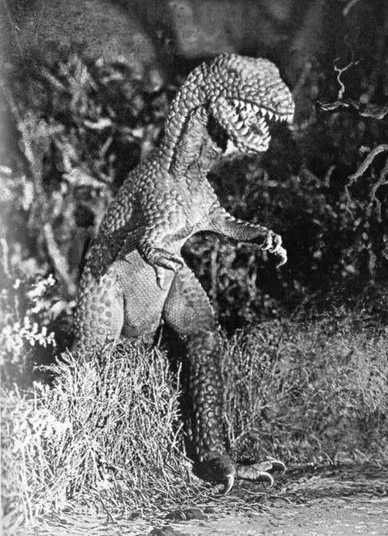Allosaurus
| |||||||||||||||||||||||||||||||||||||||||||||||||||||||||||||||||

|
This page is a sandbox. Sandboxed pages are unfinished and not yet approved. Information found here may be unpolished or unverified. |
|---|
| This article is a work in progress. Please help in the creation of this article by expanding or improving it. |
Allosaurus is an extinct genus of large carnivorous theropod dinosaurs which lived in the United States and Europe during the Late Jurassic Period.
After its discovery, Allosaurus remained extremely popular for a long time, appearing in numerous forms of media such as Walking With Dinosaurs, which even includes a special episode on a real-life Allosaurus nicknamed "Big Al". Among its the most famous appearances include appearances in The Lost World (1925). An Allosaurus-like theropod also fights King Kong in the 1933 King Kong film. It is usually depicted as a fast and dangerous predator, as it most likely was in real life.
Name
The name "Allosaurus" means "different lizard" and is a combination of two Greek words — ἄλλος (allos, meaning "different") and σαῦρος (sauros, meaning "lizard").
The theropod dinosaur from the 1933 film King Kong was not named on-screen, although it was called simply a "Meat-Eater" in its screenplay and 1932 novelization as well. Though Willis O'Brien and Marcel Delgado referred to the Meat-Eater as a Tyrannosaurus rex, Merian C. Cooper called it an Allosaurus. The Meat-Eater was also referred to as simply an allosaur in Kong Reborn, Russell Blackford's 2005 sequel to the 1932 novelization, which means that, although it may not be an Allosaurus, it is a member of the clade Allosauridae.
Appearance
Since its discovery in the 1800's, Allosaurus has generally been depicted in media as a large bipedal theropod, with two lacrimal horns resting above each eye atop its head, three fingers, and sharp teeth. Like many theropods, it was originally depicted standing upright until the 1990's, after which it was given a more horizontal stance to suit later studies on their posture and anatomy. Most modern depictions give Allosaurus a less blocky skull with more pointed lacrimal horns, arms of moderate length, and lips protecting its teeth. Its build is moderately muscled, and well suited to swift movement for an animal its size.
In The Lost World, Allosaurus' design is consistent with its early depictions of the theropod, with rough scaly skin like that of a Gila monster. It's eyebrow ridges are round and less defined than later recreations of Allosaurus.
History
The Lost World

|
This article or section needs to be cleaned up to meet the standards of Wikizilla. Reason: too short and not descriptive |

|
An Allosaurus was first seen in this film battling a Trachodon, with the battle ending after the Allosaurus grabbed the Trachodon and ripped out its throat, then allowing the hadrosaur's carcass to fall into a bog. It then menaced a Triceratops protecting its young, but retreated after the Triceratops stabbed the Allosaurus with one of its horns. It then encountered the camp where the Professor Challenger and his party were staying on the plateau, but they repelled it with their guns and by throwing a torch into its mouth. It finally challenged an Agathaumas to a battle, jumping onto the ceratopsian's back, but was killed when the Agathaumas gored it with its nose horn.
Another Allosaurus was later seen fighting a Brontosaurus, with the outcome of the Brontosaurus falling off the cliff edge of the plateau after the Brontosaurus grabbed the throat of the Allosaurus. After this, the Allosaurus simply walked away.
King Kong
- Main article: Meat-Eater.
King Kong Escapes
- Main article: Gorosaurus.
Abilities
Durability
Specimen USNM 2315, the lower jaw of an Allosaurus fragilis, shows evidence of healing after having been broken, the cause of which thought to be infraspecific combat.[3][4]
In The Lost World, the Allosaurus survived injuries from a Triceratops' horns, along with gun fire and a torch in its mouth, before succumbing to the horn of an Agathaumas.
Books
- Anthony Browne's King Kong (1994)
Anthony Browne's King Kong
An Allosaurus attacked Ann Darrow, but King Kong was able to fend it off, landing several blows. The Eighth Wonder of the World finished the theropod off by breaking its jaws, killing it.
Comics
- Konga #3 (1961)
Konga

Allosaurus is depicted on the cover of "The Rulers" story attacking a Stegosaurus, and is shown in the comic itself growling at another, larger theropod. The same dinosaur is shown in the same picture with animals from the late Cretaceous period.
Trivia
- In the 1996 script for Peter Jackson's King Kong film, which would eventually be replaced by the 2005 King Kong film, King Kong would battle a group of allosaurs, likely based on Merian C. Cooper's identification of the Meat-Eater as an Allosaurus. A similar concept would be carried into the 2005 film, but instead, Kong fights a group of Vastatosaurus rex, which were descendants of Tyrannosaurus rex.
Related characters
|
|
|
External links
References
This is a list of references for Allosaurus. These citations are used to identify the reliable sources on which this article is based. These references appear inside articles in the form of superscript numbers, which look like this: [1]
|
Comments
Showing 19 comments. When commenting, please remain respectful of other users, stay on topic, and avoid role-playing and excessive punctuation. Comments which violate these guidelines may be removed by administrators.





